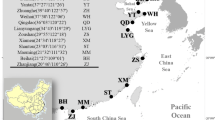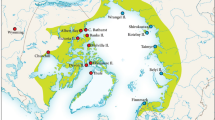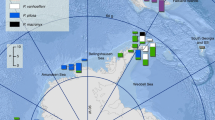Abstract
Physalia is a genus of pelagic colonial hydrozoans often known by common names such as ‘Portuguese-man-of-war’ or ‘bluebottle’. Siphonophore systematists generally recognise only a single species in this genus, Physalia physalis, however the name Physalia utriculus is also still in common use, which has led to considerable taxonomic confusion. With some morphological variation between global regions there is the possibility that this genus holds a substantial amount of cryptic variation. We seek to examine the genetic structure of Physalia present in New Zealand coastal waters. Fifty-four specimens collected from 13 locations around New Zealand and Australia were sequenced for both mitochondrial cytochrome c oxidase I (COI) and the first internal transcribed spacer (ITS1) of the nuclear ribosomal cistron. Sequences were analysed using maximum likelihood and split decomposition neighbour networks to determine conflict between clans (the unrooted analog of clades). Three clans were identified from both the COI and ITS sequences. The results are complex and clans are not consistent between the two genes. Nevertheless, it seems that there is substantial cryptic diversity amongst Physalia present in New Zealand coastal waters.








Similar content being viewed by others
References
Alam, J. M., R. Qasim, S. A. Ali, Q. Jamal & S. M. Alam, 2002. Biochemical characterization and pathophysiological properties of two high molecular weight cytolytic proteins from the venom of a coelenterate (Jellyfish), Physalia utriculus (blue bottle). Pakistan Journal of Zoology 34: 9–17.
Bensasson, D., D. X. Zhang, D. L. Hartl & G. M. Hewitt, 2001. Mitochondrial pseudogenes: evolution’s misplaced witnesses. Trends in Ecology & Evolution 16: 314–321.
Bouillon, J., C. Gravili, F. Pagès, J. Gili & F. Boero, 2006. An Introduction to Hydrozoa. Publications Scientifiques du Museum, Paris.
Brodie, J. W., 1960. Coastal surface currents around New Zealand. New Zealand Journal of Geology and Geophysics 3: 235–252.
Collins, A. G., 2002. Phylogeny of Medusozoa and the evolution of cnidarian life cycles. Journal of Evolutionary Biology 15: 418–432.
Collins, A. G., S. Winkelmann, H. Hadrys & B. Schierwater, 2005. Phylogeny of Capitata and Corynidae (Cnidaria, Hydrozoa) in light of mitochondrial 16S rDNA data. Zoologica Scripta 34: 91–99.
Collins, A. G., B. Bentlage, A. Lindner, D. Lindsay, S. H. D. Haddock, G. Jarms, J. L. Norenburg, T. Jankowski & P. Cartwright, 2008. Phylogenetics of Trachylina (Cnidaria: Hydrozoa) with new insights on the evolution of some problematical taxa. Journal of the Marine Biological Association of the United Kingdom 88: 1673–1685.
Cronin, M. A., 1993. Mitochondrial DNA in wildlife taxonomy and conservation biology: cautionary notes. Wildlife Society Bulletin 21: 339–348.
Dawson, M. N., 2003. Macro-morphological variation among cryptic species of the moon jellyfish, Aurelia (Cnidaria: Scyphozoa). Marine Biology 143: 369–379.
Dawson, M. N. & D. K. Jacobs, 2001. Molecular evidence for cryptic species of Aurelia aurita (Cnidaria, Scyphozoa). Biological Bulletin 200: 92–96.
Dayrat, B., 2005. Towards integrative taxonomy. Biological Journal of the Linnean Society 85: 407–415.
Drummond, A. J. & A. Rambaut, 2007. BEAST: Bayesian evolutionary analysis by sampling trees. BMC Evolutionary Biology 7: 214.
Drummond, A. J. & M. A. Suchard, 2010. Bayesian random local clocks, or one rate to rule them all. BMC Biology 8: 114.
Drummond, A. J., S. Y. W. Ho, M. J. Phillips & A. Rambaut, 2006. Relaxed phylogenetics and dating with confidence. PLoS Biology 4(5): e88.
Dunn, C. W., P. R. Pugh & S. H. D. Haddock, 2005. Molecular phylogenetics of the Siphonophora (Cnidaria), with implications for the evolution of functional specialization. Systematic Biology 54: 916–935.
Fenner, P. J., 1997. The Global Problem of Cnidarian (Jellyfish) Stinging. University of London, London.
Folmer, O., M. Black, W. Hoeh, R. Lutz & R. Vrijenhoek, 1994. DNA primers for amplification of mitochondrial cytochrome C oxidase subunit I from diverse metazoan invertebrates. Molecular Marine Biology and Biotechnology 3: 294–299.
Gardner, D. M., 1961. Hydrology of New Zealand coastal waters. Bulletin of the New Zealand Department of Scientific and Industrial Research 138: 1–84.
Goulet, T. L. & M. A. Coffroth, 2003. Genetic composition of zooxanthellae between and within colonies of the octocoral Plexaura kuna, based on small subunit rDNA and multilocus DNA fingerprinting. Marine Biology 142: 233–239.
Govindarajan, A. F., K. K. Halanych & C. W. Cunningham, 2005. Mitochondrial evolution and phylogeography in the hydrozoan Obelia geniculata (Cnidaria). Marine Biology 146: 213–222.
Hebert, P. D. N., A. Cywinska, S. L. Ball & J. R. DeWaard, 2003. Biological identifications through DNA barcodes. Proceedings of the Royal Society of London – Biological Sciences 270: 313–322.
Hebert, P. D. N., J. R. de Waard & J.-F. Landry, 2010. DNA barcodes for 1/1000th of the animal kingdom. Biology Letters 6: 359–362.
Hills, D. M. & S. K. Davis, 1986. Evolution of ribosomal DNA: fifty million years of recorded history in the frog genus Rana. Evolution 40: 1275–1288.
Huang, D., R. Meier, P. A. Todd & L. M. Chou, 2008. Slow mitochondrial COI sequence evolution at the base of the metazoan tree and its implications for DNA barcoding. Journal of Molecular Evolution 66: 167–174.
Hudson, D. H. & D. Bryant, 2006. Application of phylogenetic networks in evolutionary studies. Molecular Biology and Evolution 23: 254–267.
Knowlton, N., 2000. Molecular genetic analyses of species boundaries in the sea. Hydrobiologia 420: 73–90.
Lamark, J. B., 1801. Systeme des animaux sans vertebres. Museum National d’Histoire Naturelle, Paris.
Lane, C. E., 1960. The Portuguese man-of-war. Scientific America 2002: 158–168.
Le Goff-Vitry, M. C., A. D. Rogers & D. Baglow, 2004. A deep-sea slant on the molecular phylogeny of the Scleractinia. Molecular Phylogenetics and Evolution 30: 167–177.
Lohse, K., 2009. Can mtDNA barcodes be used to delimit species? A response to Pons et al. (2006). Systematic Biology 58: 439–442.
Loytynoja, A. & N. Goldman, 2005. An algorithm for progressive multiple alignment of sequences with insertions. Proceedings of the National Academy of Sciences of the United States of America 102: 10557–10562.
Mallet, J., 1995. A species definition for the modern synthesis. Trends in Ecology & Evolution 10: 294–299.
Mandojana, R. M., 1990. Granuloma annulare following bluebottle jellyfish (Physalia utriculus) sting. Journal of Wilderness Medicine 1: 220–224.
McFadden, C. S., 1999. Genetic and taxonomic relationships among Northeastern Atlantic and Mediterranean populations of the soft coral Alcyonium coralloides. Marine Biology 133: 171–184.
McFadden, C. S. & M. B. Hutchinson, 2004. Molecular evidence for the hybrid origin of species in the soft coral genus Alcyonium (Cnidaria: Anthozoa: Octocorallia). Molecular Ecology 13: 1495–1505.
Meyer, C. P. & G. Paulay, 2005. DNA barcoding: error rates based on comprehensive sampling. Public Library of Science, Biology 3: 2229–2238.
Monaghan, M. T., R. Wild, M. Elliot, T. Fujisawa, M. Balke, D. J. G. Inward, D. C. Lees, R. Ranaivosolo, P. Eggleton, T. G. Barraclough & A. P. Vogler, 2009. Accelerated species inventory on Madagascar using coalescent-based models of species delineation. Systematic Biology 58: 298–311.
Moritz, C., 1994. Applications of mitochondrial DNA analysis in conservation: a critical review. Molecular Ecology 3: 401–411.
Moura, C. J., D. J. Harris, M. R. Cunha & A. D. Rogers, 2008. DNA barcoding reveals cryptic diversity in marine hydroids (Cnidaria, Hydrozoa) from coastal and deep-sea environments. Zoologica Scripta 37: 93–108.
Ortman, B. D., A. Bucklin, F. Pagès & M. Youngbluth, 2010. DNA barcoding the Medusozoa using mtCOI. Deep-Sea Research II 57: 2148–2156.
Pagès, F. & J. Gili, 1992. Siphonophores (Cnidaria, Hydrozoa) of the Benguela Current (southeastern Atlantic). Scientia Marina 56: 65–112.
Palumbi, S. R., 1992. Marine speciation on a small planet. Trends in Ecology & Evolution 7: 114–118.
Papadopoulou, A., M. T. Monaghan, T. G. Barraclough & A. P. Vogler, 2009. Sampling error does not invalidate the Yule-coalescent model for species delimitation. A response to Lohse (2009). Systematic Biology 58: 442–444.
Pons, J., T. G. Barraclough, J. Gomez-Zurita, A. Cardoso, D. P. Duran, S. Hazell, S. Kamoun, W. D. Sumlin & A. P. Vogler, 2006. Sequence-based species delimitation for the DNA taxonomy of undescribed insects. Systematic Biology 55: 595–609.
Posada, D. & K. Crandall, 1998. MODELTEST: testing the model of DNA substitution. Bio Informatics 14: 817–818.
Rich, S. M., B. M. Rosenthal, S. R. Telford, A. Spielman, D. L. Hartl & F. J. Ayala, 1997. Heterogeneity of the internal transcribed spacer (ITS-2) region within individual deer ticks. Insect Molecular Biology 6: 123–129.
Swofford, D., 2003. PAUP*: Phylogenetic Analysis Using Parsimony (and Other Methods) 4.0 Beta. Sinauer Associates, Sunderland.
Totton, A. K., 1960. Studies on Physalia physalis: natural history and morphology. Discovery Reports 30: 301–368.
van Oppen, M. J. H., H. W. Willis, W. J. A. van Vugt & D. J. Miller, 2000. Examination of species boundaries in the Acropora cervicornis group (Scleractinia, Cnidaria) using nuclear DNA sequence analyses. Molecular Ecology 9: 1363–1373.
Ward, R. D., T. S. Zemlak, B. H. Innes, P. R. Last & P. D. N. Hebert, 2005. DNA barcoding Australia’s fish species. Philosophical Transactions of the Royal Society of London. Series B, Biological Sciences 360: 1847–1857.
Wilkinson, M., J. O. McInerney, R. P. Hirt, P. G. Foster & T. M. Embley, 2007. Of clades and clans: terms for phylogenetic relationships in unrooted trees. Trends in Ecology & Evolution 22: 114–115.
Yanagihara, A. A., J. M. Y. Kuroiwa, L. Oliver, & D. D. Kunkel, 2002. The ultrastructure of nematocysts from the fishing tentacle of the Hawaiian bluebottle, Physalia utriculus (Cnidaria, Hydrozoa, Siphonophora). Hydrobiologia 489: 139–150.
Zhang, S., C. Zhang & Q. Yang, 2003. Data preparation for data mining. Applied Artificial Intelligence 17: 375–381.
Zhang, L. Q., G. T. Wang, W. J. Yao, W. X. Li & Q. Gao, 2009. Molecular systematics of medusae in the genus Craspedacusta (Cnidaria: Hydrozoa: Limnomedusae) in China with the reference to the identity of species. Journal of Plankton Research 31: 563–570.
Acknowledgments
We would like to thank Surf Life Saving Taranaki, Michael and Pip Taylor, Simon and Gill Pontin, Mount Maunganui Lifeguard Service, Glenn Moore, Jared Fritchley, Sam Brown and Tom Trnski for providing specimens, Brenden Holland for providing additional Physalia sequences, Norma Merrick for assistance with DNA sequencing, Brian Ortman for locality information for Genbank sequences, and three anonymous reviewers for their insightful and constructive comments and suggestions. This study was funded by a Lincoln University PhD scholarship.
Author information
Authors and Affiliations
Corresponding author
Additional information
Handling editor: Sigrún Huld Jónasdóttir
Electronic supplementary material
Below is the link to the electronic supplementary material.
Rights and permissions
About this article
Cite this article
Pontin, D.R., Cruickshank, R.H. Molecular phylogenetics of the genus Physalia (Cnidaria: Siphonophora) in New Zealand coastal waters reveals cryptic diversity. Hydrobiologia 686, 91–105 (2012). https://doi.org/10.1007/s10750-011-0994-8
Received:
Revised:
Accepted:
Published:
Issue Date:
DOI: https://doi.org/10.1007/s10750-011-0994-8




